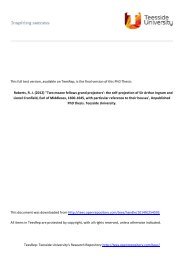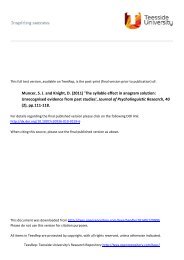Maruthamuthu, S. et al. - Teesside's Research Repository
Maruthamuthu, S. et al. - Teesside's Research Repository
Maruthamuthu, S. et al. - Teesside's Research Repository
You also want an ePaper? Increase the reach of your titles
YUMPU automatically turns print PDFs into web optimized ePapers that Google loves.
EDX<br />
Figures 11 and 12 show the spectrum received from EDX for cupronickel in the presence<br />
and absence of Bacillus sp. in nitrogen free medium. The percentage weight of copper,<br />
nickel, iron and oxygen were an<strong>al</strong>yzed on the cupronickel and presented in table VII. In<br />
the control system 87.68% of copper and 10.40% of nickel were noticed <strong>al</strong>ong with 2%<br />
iron, where iron acts as passivator. In the experiment<strong>al</strong> system, the center of pitted<br />
surface had 90.53% of copper, 8.85% of nickel and 0.62% of iron. The iron content was<br />
lower on pitted surface indicating the initiation of pitting at lower iron adsorbed area. At<br />
point 2 (edge of the pit) the iron and copper contents were 0.19 and 79.96% respectively<br />
whereas oxygen was 8.96%. It indicates that the edge consists of cuprous oxide on the<br />
m<strong>et</strong><strong>al</strong> surface. The reduction of iron on the cupronickel in the presence of Bacillus sp.<br />
may be due to the use of iron as nutrient by Bacillus sp., which is a cofactor for<br />
nitrogenase enzyme (Smith <strong>et</strong> <strong>al</strong>., 1999). Besides, it can be inferred that the oxide film<br />
was broken by biogenic ammonia and has resulted in pitting.<br />
Atomic force microscope<br />
Atomic force microscopic observations were done for cupronickel 90:10 in the presence<br />
and absence of bacteria and are presented in the figures 13 a & b. The adsorption of<br />
nutrients present in the nitrogen-free medium can be seen in the control system. The film<br />
was h<strong>et</strong>erogonous in nature (figure. 13a). It indicates the presence of inhibitor like iron<br />
sulphate and molybdenum adsorbed on the m<strong>et</strong><strong>al</strong> surface. In the bacteri<strong>al</strong> system pitting<br />
and inter granular crack could be noticed. The depth of the largest pit was 1000nm<br />
(Figure 13b).<br />
According to the literature two reaction schemes are possible for tenorite<br />
formation. The reduction of positive three v<strong>al</strong>ent nitrogen in nitrite ion to negative, three<br />
v<strong>al</strong>ent in ammonia takes place (Todt <strong>et</strong> <strong>al</strong>., 1961; Kirchberg <strong>et</strong> <strong>al</strong>., 2001). Apart from the<br />
nitrogenase enzyme, the denitrification process proposed by Tiedje <strong>et</strong> <strong>al</strong>. (1988) involves<br />
four stages viz; reduction of nitrate to ammonia via nitrate, hyponitrite and<br />
hydroxylamine. In the present study, it is assumed that nitrogenase enzyme is the most<br />
important factor for nitrogen fixation (Abdel Wahab <strong>et</strong> <strong>al</strong>.,1975) from atmospheric di-<br />
13





